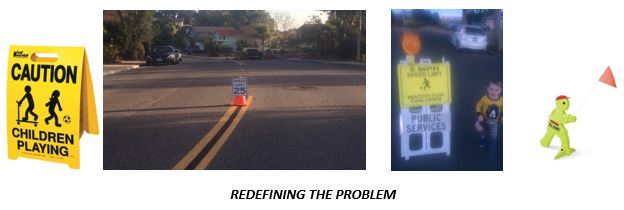Civic Center Crosswalk in Fremont, CA
Tactical Urbanism Creating Opportunities from Challenges to better move and connect people and businesses so that communities can THRIVE!
Level of service was a solution of the Federal and State Interstate Highway era. The LOS concept was introduced in the 1965 Highway Capacity Manual to help "appropriately" size and design Federal and State highways. Unfortunately that solution was quickly accepted as the standard of measure for highways and freeways (largest and most expensive public works project in United States history that still continues today) and was later modified and adopted by local communities to size and design their roadways. The difference is that local communities serve "people" and many of our interstate highways prohibit or discourage or scare most people from using them. So when the LOS HCM solution was used in communities, our roadways often became sterile of human life (except if people were in a car). Our community "people moving and connecting" roadways started looking and feeling like interstate highways. These community roadways became bigger, wider, and faster contributing to hundreds of thousands of life altering collisions and as a result became barriers within communities to move and connect people, neighborhoods, schools and businesses. So maybe we need to redefine the problem we are trying to solve and how we as communities serve our people and businesses.
#1 COMPLAINT from PEOPLE in COMMUNITIES - MOTORISTS DRIVE TOO FAST
As a result, the people are starting to take action to take back their streets from vehicle (even their residential streets) back from this bigger, wider, and faster roadways mantra.
Fast forward, fifty years and communities are focused on revitalizing their downtowns, calming traffic in residential neighborhoods, creating economic vibrancy, building transit oriented development, struggling to identify ways to maintain their infrastructure, and focused on identifying ways to move and connect people and businesses more effectively and safely. And the Federal and State governments have created environmental regulations on greenhouse gases and air quality and are now providing public health care. Both of which are directly impacted by our built communities and how we move and connect people. The challenge is that there is this man-made "rule" called "LOS" that was developed to solve a different defined problem fifty years ago and this "rule" is perceived to be in the way, forcing us as planners and engineers to do things right rather than focus on doing the right things. How we define the problem will often determine the solutions and opportunities. Focusing on the right things and not doing things right is the difference in being effective and efficient. Because of how the problem is defined you could be doing the wrong things right and efficiently. I would rather my community be sustainable (economically, socially, public health and environmentally) and effective rather than efficiently building roadways based on the wrong set of solutions. It is time to redefine the problem, change the rules, and focus on building sustainable and effective communities that better serve its people and businesses. California is doing just that with SB 743 and hopefully communities will see the many opportunities available to them as LOS becomes a distant vision in the rear view mirror.
UTILIZING TACTICAL URBANISM to MOVE and CONNECT PEOPLE and BUSINESSES
In my first hour in the Public Works Director position with Fremont, CA, I was asked to solve a safety crossing situation for the Washington Hospital campus (largest employer in downtown Fremont) adjacent to the BART transit station where seven recent pedestrian-vehicle, life altering injury collisions occurred because of distracted motorists and pedestrians and speed of motorists. Both the City and Hospital were debating the solution, or the "what's", and the issue quickly escalated into what I call a "kidney stone" project; small but politically painful. Engineers were concerned about manmade warrants and policies and the old "we don't want to create a false sense of security for pedestrians." The hospital wanted something done to improve pedestrian safety crossing a city roadway that bisected their hospital campus and created a barrier between Fremont's downtown and a BART regional mass transit station. So, we brought a fresh perspective and took a step back to focus everyone on the "why" and when we came to agreement on the "why" the solution presented itself. The "why" was to improve pedestrian safety or in short make the pedestrian "King of the Roadway." When you make a roadway safe for people, the most vulnerable users of the roadway, you enhance the safety for all users of the roadway. We then utilized the Aim Frame approach of "What is the current situation?", "What do we want to create?", and "How do we want to get there?" to identify the "how" and "what" to improve pedestrian safety. The solution pictured below and shared in the attached video was implemented by maintenance crews within two months utilizing a "Tactical Urbanism" approach, in time for the State of the City speech by the Mayor. What was once a significant safety issue creating political confrontation for over two years, resulted in the Hospital CEO and Board President attending a council meeting with a 2' x 3' card signed by the entire hospital staff saying "thank you".
How many capacity enhancing vehicle projects receive "thank you" cards from vehicles? It takes people and businesses to write thank you cards. When we focus on serving the people and businesses our relevancy as engineers and planners becomes greatly appreciated and valued.
The Tactical Urbanism Project
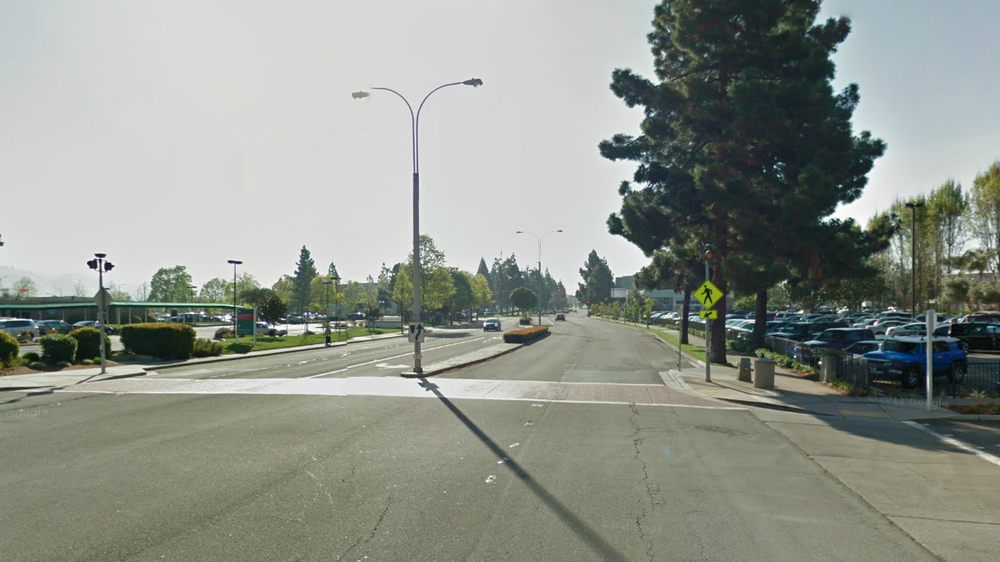
The original four lane roadway designed for efficiency of moving vehicles that bisects the hospital campus and downtown Fremont from the adjacent BART station.
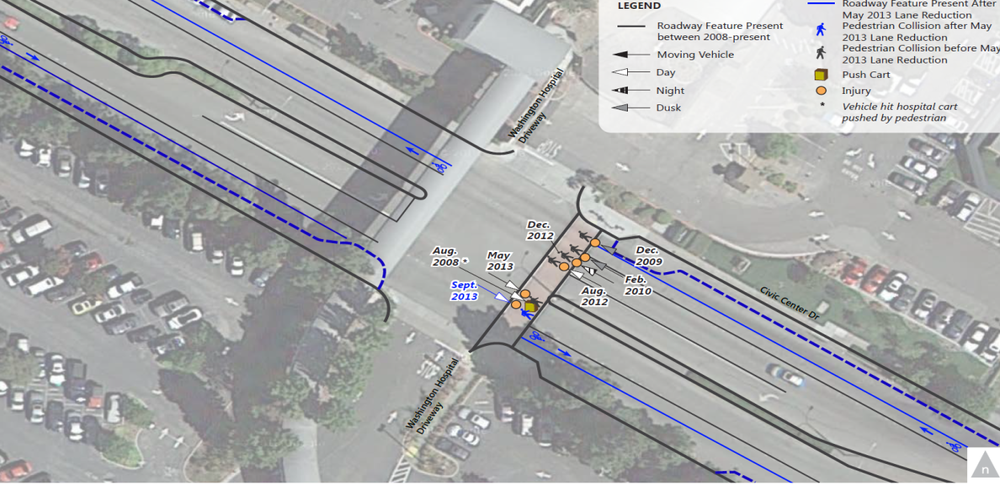 The above graphic shows the six vehicle-pedestrian collisions prior to the road diet (lane reduction from four to two lanes) completed in May 2013. After which another vehicle-pedestrian collision occurred in September 2013 so something additional needed to be done to enhance pedestrian safety at this midblock crosswalk.
The above graphic shows the six vehicle-pedestrian collisions prior to the road diet (lane reduction from four to two lanes) completed in May 2013. After which another vehicle-pedestrian collision occurred in September 2013 so something additional needed to be done to enhance pedestrian safety at this midblock crosswalk.
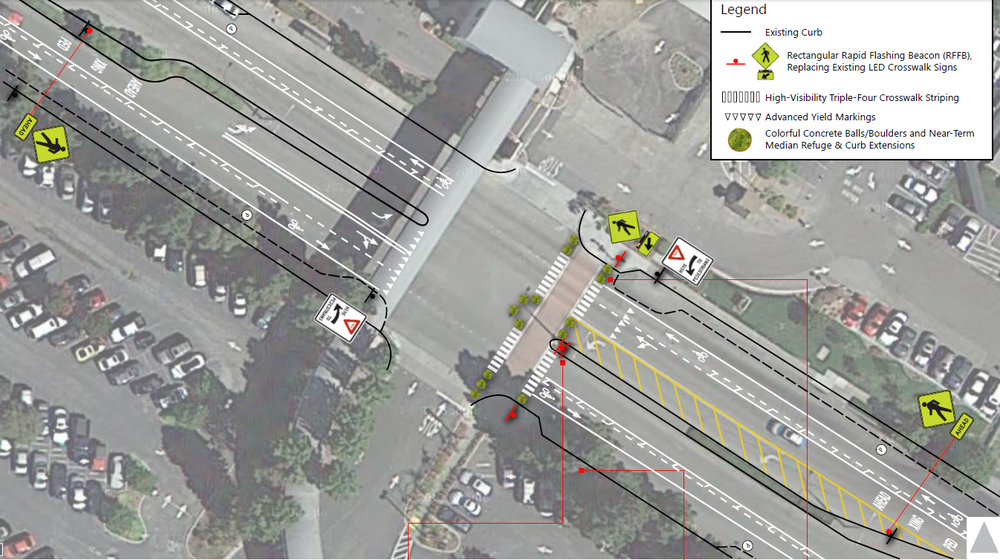 The concept solution design to facilitate discussion between the Hospital leadership and City Leadership.
The concept solution design to facilitate discussion between the Hospital leadership and City Leadership.
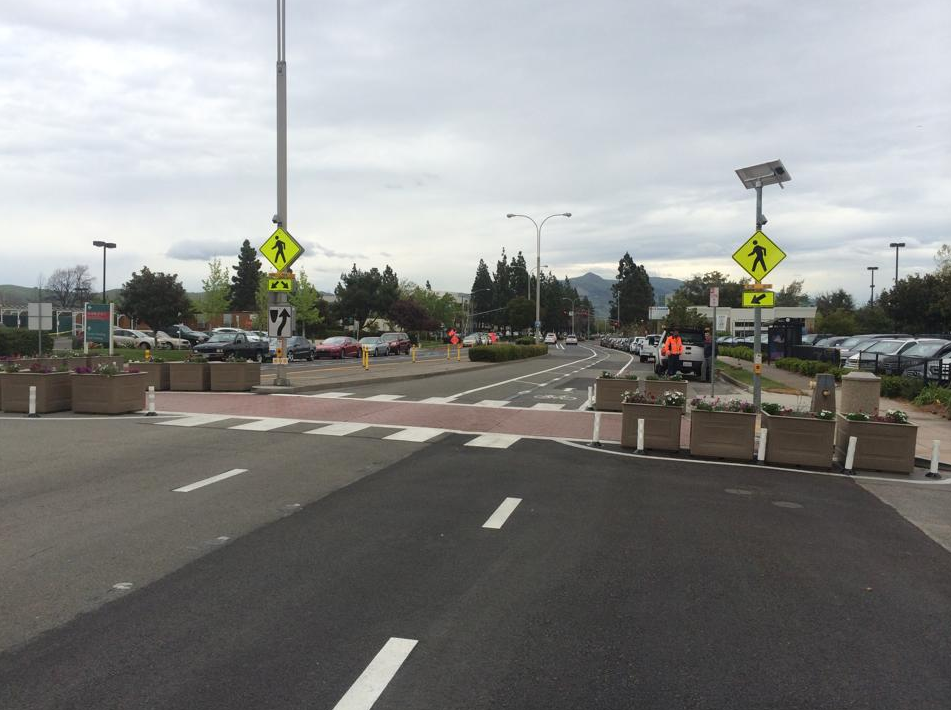 The concept plan implemented within 6-8 weeks by city professional street maintenance crews included plastic water filled planter boxes to create curb extensions and a median island to reduce exposure of the pedestrian crossing the roadway. Solar powered Rectangular Rapid Flashing Beacons with passive (pedestrian motion detection) and active (push button) activation were also installed to warn motorists of pedestrians.
The concept plan implemented within 6-8 weeks by city professional street maintenance crews included plastic water filled planter boxes to create curb extensions and a median island to reduce exposure of the pedestrian crossing the roadway. Solar powered Rectangular Rapid Flashing Beacons with passive (pedestrian motion detection) and active (push button) activation were also installed to warn motorists of pedestrians.
 Travel lanes were narrowed to 9' in width as 12-13' wide travel lanes are designed for freeway use at 55-80 MPH. Narrower travel lanes help reduce motorists speeds. And motorists' speeds have a direct correlation with severity of collisions on a roadway. Above the left-turn lane was closed to reduce the "multiple threat" collision of a vehicle blocking on-coming motorists of seeing a pedestrian crossing in the midblock crosswalk. Left-turn lanes and right turn lanes were originally created to enhance the capacity and efficiency of a roadway for vehicles but they also increased the distance and exposure of a pedestrian crossing the roadway.
Travel lanes were narrowed to 9' in width as 12-13' wide travel lanes are designed for freeway use at 55-80 MPH. Narrower travel lanes help reduce motorists speeds. And motorists' speeds have a direct correlation with severity of collisions on a roadway. Above the left-turn lane was closed to reduce the "multiple threat" collision of a vehicle blocking on-coming motorists of seeing a pedestrian crossing in the midblock crosswalk. Left-turn lanes and right turn lanes were originally created to enhance the capacity and efficiency of a roadway for vehicles but they also increased the distance and exposure of a pedestrian crossing the roadway.
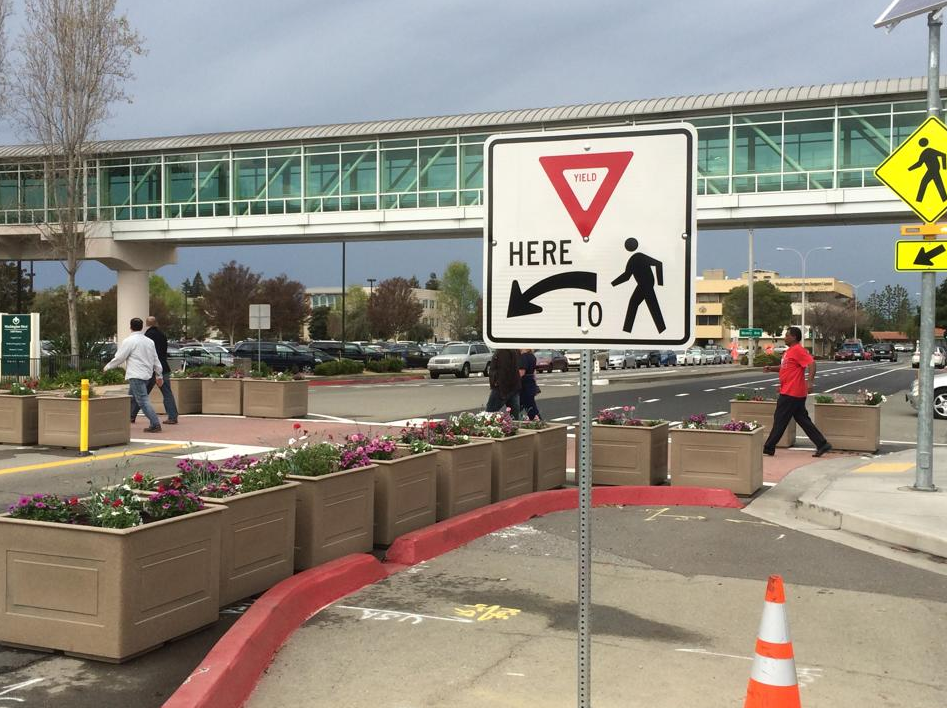 Advanced "yield" lines and regulatory "yield here to pedestrians" were utilized to bring greater awareness to motorists crossing in the crosswalk and where motorists should yield to pedestrians. The red AC Dike was used in May of 2013 to implement the road diet (lane reduction). However, there was still room for planter boxes and bike lanes to help narrow the crossing and reduce motorists' speeds.
Advanced "yield" lines and regulatory "yield here to pedestrians" were utilized to bring greater awareness to motorists crossing in the crosswalk and where motorists should yield to pedestrians. The red AC Dike was used in May of 2013 to implement the road diet (lane reduction). However, there was still room for planter boxes and bike lanes to help narrow the crossing and reduce motorists' speeds.
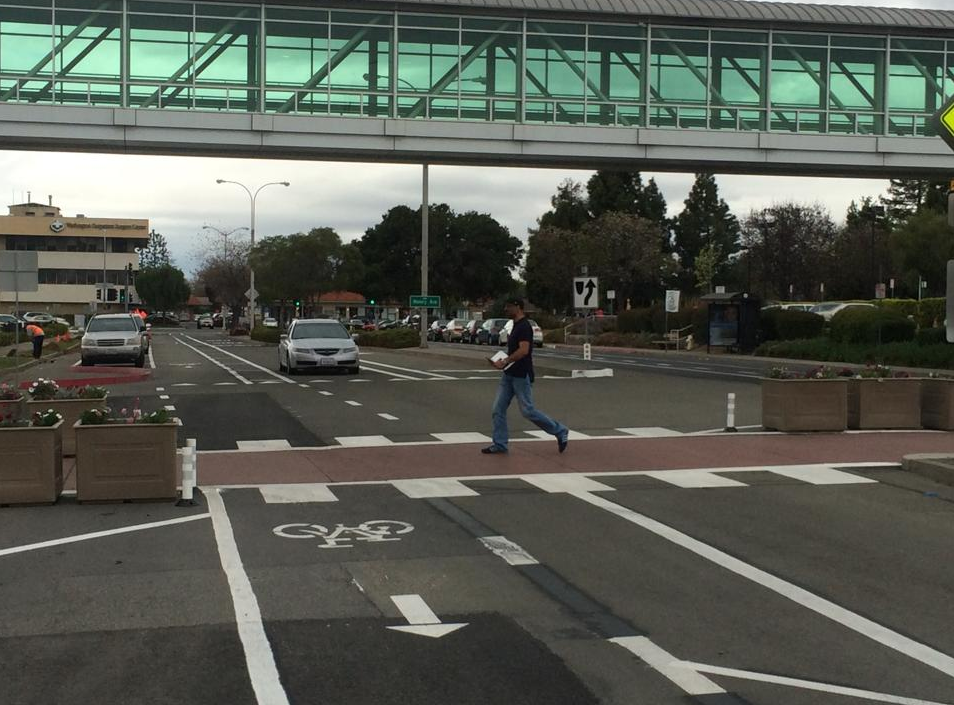
You might ask why the Pedestrian Grade Separated Overcrossing is not used by the thousands of pedestrians (from both BART and Washington Hospital) crossing in the crosswalk. And that overcrossing goes from the 2nd floor of one building to the 2nd floor of the other building. It is not the quickest or most direct path of travel for pedestrians. Many of the pedestrians are not employees or customers/clients of the hospital. In this picture you can see the buffered bike lanes and narrow travel lanes. Notice that the motorist is stopping at the yield line. And there is still plenty of space for all the transit buses going to the BART station and ambulances and fire trucks going to the hospital.
The result of the "tactical urbanism" implementation was an increase of compliance for motorists stopping for pedestrians from 20% to nearly 90%.
The counterintuitive question we asked when narrowing travel lanes was: “Can making the roadway feel less safe to a driver’s perception (while still safe by all design standards) by narrowing the travel lanes actually increase safety by enhancing a motorist’s focus and awareness of the roadway?”
The answer was yes. Asking questions is the first step to reaching new solutions.
Bryan Jones, PE, PTP, AICP is a Senior Associate with Alta Planning + Design and the former Public Works Director for the City of Fremont. He has also held leadership positions with the Cities of Carlsbad and Fresno where he has inspired bold visions and big campaigns and aligned them with a strategic implementation plans that delivered numerous pedestrian, bicyclist, and complete and livable street projects. Bryan is passionate about helping move and connect people and business so that communities can thrive. He strives to foster innovation and develop leadership so that we can move in the direction of our potential. He believes where challenges exist so do opportunities when we redefine the problem we are solving and bring a can-do approach and results-oriented focus. He also serves as a voting member of the California Traffic Control Devices Committee appointed by the State of California DOT to represent bicyclists and pedestrians statewide as it pertains to standards, guidelines and policies in the California Manual for Uniform Traffic Control Devices. He received his civil engineering degree from UC Davis and his MPA from Norwich University.

